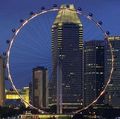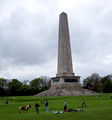Template:Obelisks
Most often, pairs of giant monoliths of red granite from Aswan were erected in front of the massive double towers of a temple gateway. As a symbol of the sun, the creator-god of the ancient Egyptian pantheon, the giant obelisks marked the temple as a zone of sun worship. Therefore obelisks are not found in front of every temple, but only in temples associated with the sun-god. [9]
- The pagan association of the obelisk was something well understood by the church. The Jesuit scholar, Athanasius Kircher [10] in his book Obeliscus Pamphilius, published in 1650, gives an account of the ancient views of the obelisk as the "digitus solis", or "finger of the sun" . Pope Sixtus V (1585 - 1590) had the Egyptian obelisks erected all over Rome, as Counter-Reformation monuments. [11] (Also see: Nature as model: Salomon de Caus and early seventeenth-century landscape design p. 174, By Luke Morgan)
- The word matstsebah in Hebrew means standing images or obelisk and it can be found in many places of the Bible. Here is Strong's definition of the Hebrew word matstsebah: H4676. matstsebah, mats-tsay-baw; fem. (causat.) part. of H5324; something stationed, i.e. a column or (memorial stone); by anal. an idol:--garrison, (standing) image, pillar.
- In the following verses matstsebah has been translated as image(s)-
- Exo 23:24 Thou shalt not bow down to their gods, nor serve them, nor do after their works: but thou shalt utterly overthrow them, and quite break down their images.
- Exo 34:13 But ye shall destroy their altars, break their images, and cut down their groves:
- Lev 26:1 Ye shall make you no idols nor graven image, neither rear you up a standing image, neither shall ye set up any image of stone in your land, to bow down unto it: for I am the LORD your God.
- Deu 7:5 But thus shall ye deal with them; ye shall destroy their altars, and break down their images, and cut down their groves, and burn their graven images with fire.
- Deu 12:3 And ye shall overthrow their altars, and break their pillars, and burn their groves with fire; and ye shall hew down the graven images of their gods, and destroy the names of them out of that place.
- 1 Ki 14:23 For they also built them high places, and images, and groves, on every high hill, and under every green tree.
- 2 Ki 3:2 And he wrought evil in the sight of the LORD; but not like his father, and like his mother: for he put away the image of Baal that his father had made.
- 2 Ki 10:26 And they brought forth the images out of the house of Baal, and burned them.
- 2 Ki 10:27 And they brake down the image of Baal, and brake down the house of Baal, and made it a draught house unto this day.
- 2 Chr 14:3 For he took away the altars of the strange gods, and the high places, and brake down the images, and cut down the groves:
- 2 Chr 31:1 Now when all this was finished, all Israel that were present went out to the cities of Judah, and brake the images in pieces, and cut down the groves, and threw down the high places and the altars out of all Judah and Benjamin, in Ephraim also and Manasseh, until they had utterly destroyed them all. Then all the children of Israel returned, every man to his possession, into their own cities.
- Jer 43:13 He shall break also the images of Bethshemesh, that is in the land of Egypt; and the houses of the gods of the Egyptians shall he burn with fire.
- Micah 5:13 Thy graven images also will I cut off, and thy standing images out of the midst of thee; and thou shalt no more worship the work of thine hands.
- In the following verses matstsebah has been translated as image(s)-
- Another Hebrew word is also used for "sun images" or obelisks, the word chamman. Again, here is the Strong's definition-: H2553. chamman, kham-mawn; from H2535; a sun-pillar:--idol, image.
- Chamman is also translated as simply image(s) in the King James:
- Isa 17:8 And he shall not look to the altars, the work of his hands, neither shall respect that which his fingers have made, either the groves, or the images.
- Isa 27:9 By this therefore shall the iniquity of Jacob be purged; and this is all the fruit to take away his sin; when he maketh all the stones of the altar as chalkstones that are beaten in sunder, the groves and images shall not stand up.
- 2 Chr 34:4 And they brake down the altars of Baalim in his presence; and the images, that were on high above them, he cut down; and the groves, and the carved images, and the molten images, he brake in pieces, and made dust of them, and strowed it upon the graves of them that had sacrificed unto them.
- Chamman is also translated as simply image(s) in the King James:
- The word matstsebah in Hebrew means standing images or obelisk and it can be found in many places of the Bible. Here is Strong's definition of the Hebrew word matstsebah: H4676. matstsebah, mats-tsay-baw; fem. (causat.) part. of H5324; something stationed, i.e. a column or (memorial stone); by anal. an idol:--garrison, (standing) image, pillar.
- Masonic explanation
- From Masonic Literature, the only place where we can get some understanding of the symbols we are confronted with when we go to Rome and visit St Peter's Square. "The Sun is symbolized by a point in the middle in Freemasonry.. In this case the obilisk serves as the middle. The Ancient Astronomers saw all the great Symbols of Masonry in the Stars, (l'Etoile Flamboyante). The Sun is still symbolized by the point within a Circle; and, with the Moon and Mercury or Anubus, in the three Great Lights of the Lodge. .. (they) were ascribed peculiar divine powers. (It is also) an emblem of UNITY. (Morals and Dogma , by Albert Pike- p. 486) "The celebrated Labyrinth was built in honor of the Sun; and its twelve palaces, like the twelve superb columns of the Temple at Hieroplolis. The figure of the pyramid (on top of the obelisk) and that of the obelisk, resembling the shape of a flame, caused these monuments to be consecrated to the Sun and the Fire. Obelisks were erected in honor ot the Sun. (Ibid., - p.459,460). The worship of the Sun became the basis of all the religions of antiquity. To them the Sun is author of life, heat, and ignition.. His (the sun's) beneficient influences caused his identification with the Principle of Good; and the Brahma of the Hindus, the Mithras of the Persians, and Athom, Phtha, and Osiris, of the Egyptians. the Bel of the Chaldeans, the Adonai of the Phoenicians, the Adonis and Apollo of the Greeks became but personifications of the Sun, the regenerating Principle, image of that fecundity which perpetuates and rejuvenates the world's existence. (Ibid., - p. 593) [12]
- Various notes:
- The obelisk enacts the same formula as the pyramid - maximum height for minimum base - but in different material, leading to different scale and architectural setting. The tip of the obelisk might be covered in shining metal - gold or the gold-silver alloy electrum; this would catch the first ray of the sun just before dawn, dramatising the illuminating and life-giving power of the creator. These effects are specified in the inscriptions of New Kingdom obelisks, which also make clear the intimate relation of king and sun-god (see the pages on kingship on this website). [13]
- The obelisk consists of four trapezoids and a pyramid capstone. [14]
- See also:
- Asherah In Israel and Judah and Asherah pole
- Ogham & Ogham Stones
- Occult symbolism: Phallus
- Roman triumph: "a civil ceremony and religious rite of ancient Rome. Its origins and development remain obscure: ancient Roman historians placed the first triumph in the mythical past. The triumph publicly celebrated and sanctified the military achievements of an army commander who had won great military successes"
- "Obelisk's of the world"
- "Does your Church worship Baal?"
- "Grover's Guide to Campus Phallic Symbols"
- "Be Fruitful and Multiply"
- To research: Phoenician Beth-el ("house/stone of god"). See also: Betyle stone.
- The obelisk enacts the same formula as the pyramid - maximum height for minimum base - but in different material, leading to different scale and architectural setting. The tip of the obelisk might be covered in shining metal - gold or the gold-silver alloy electrum; this would catch the first ray of the sun just before dawn, dramatising the illuminating and life-giving power of the creator. These effects are specified in the inscriptions of New Kingdom obelisks, which also make clear the intimate relation of king and sun-god (see the pages on kingship on this website). [13]
Karnak obelisk, (near Luxor, Egypt)
Heliopolis obelisk (without hieroglyphs??), Saint Peter's Square, Vatican City (placed in 1586) (see also: Obelisks in Rome)
Heliopolis obelisk obelisk, Piazza del Popolo, Rome, Italy (placed in 1589)
Sanssouci obelisk, Potsdam, Germany (build in 1747)
Gamla stan, Sweden (build in 1800)
Heliopolis obelisk, Paris (placed in 1833 from Thebes, Egypt)
Bunker Hill Monument, Charlestown, Massachusetts, US. (build between 1827 and 1843)
District of Columbia obelisk (build between 1848-1884)
See also: [1]Hyde Park Obelisk, Sydney, Australia (build in 1857)
Heliopolis obelisk, City of London (placed in 1878 from Alexandria, Egypt)
Heliopolis obelisk, New York (placed in 1881 from Alexandria, Egypt)
Bennington Battle Monument, Vermont, US. (build in 1889)
Buenos Aires obelisk, Argentina (built in 1936)
San Jacinto Monument, US (build in 1939)
Note the pentagram top and the nearby pyramid object. See also: [2].Altamira, Caracas, Venezuela (build in 1944)
Obelisk of São Paulo, Brazil (build between 1944-1970)
Halde Hoheward, Germany (build in ?)
Messeturm, Frankfurt am Main, Germany (1991).
It is the second tallest building in Germany and the also the second tallest in the European Union.? building in Singapore.
In the background is the Singapore Flyer ferris wheel.The 2nd tallest obelisk in the world--2nd only to the Washington Monument, Phoenix Park , Dublin.
Note: The Phoenix is the Masonic animal by Excellence.Obelisk Yad Vashem Holocaust Memorial-Jerusalem inside an six pointed star (surrounded by 6 hexagons) [3]
Obelisk on the Malecon in Santo Domingo to commemorate the Mirabal Sisters [4]
- Obelisk graves of the 'elite':
Obelisk grave marker of John D. Rockefeller
Obelisk gravestone of Thomas Jefferson
Obelisk gravestone of James Madison
- Black obelisks:
The Obelisk of Manishtushu found at Susa [5]
This black obelisk was erected by Assyrian king Shalmaneser III (858-824 BC). [6]
Black siltstone obelisk of King Nectanebo II of Egypt, Thirtieth dynasty, about 350 BC. According to the vertical inscriptions Nectanebo set up this obelisk at the doorway of the sanctuary of Thoth, the Twice-Great, Lord of Hermopolis.
"This Obelisk, erected for Francis North of Guildford, is in memorandum of the exceptional hospitality shown to Frederick the Prince of Wales, most noble, during his stay at the Wroxton Abbey, September 1739" [7]
Obelisk in Elmwood Historic Cemetery on grave of successful banker and capitalist "J.J. Squier". [8]
Fritz Scholder's Obelisk at the National Museum of the American Indian- Washington DC




































